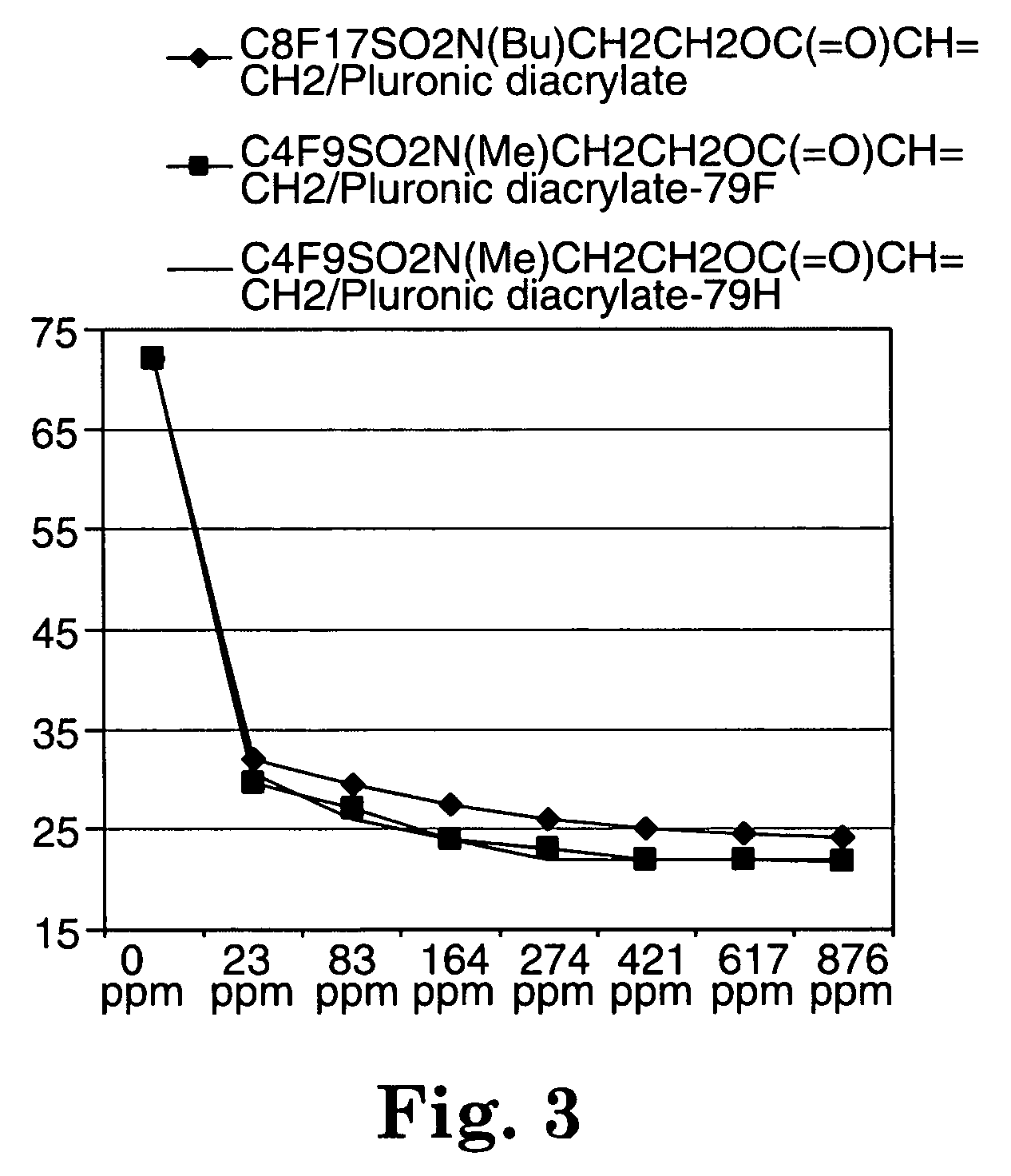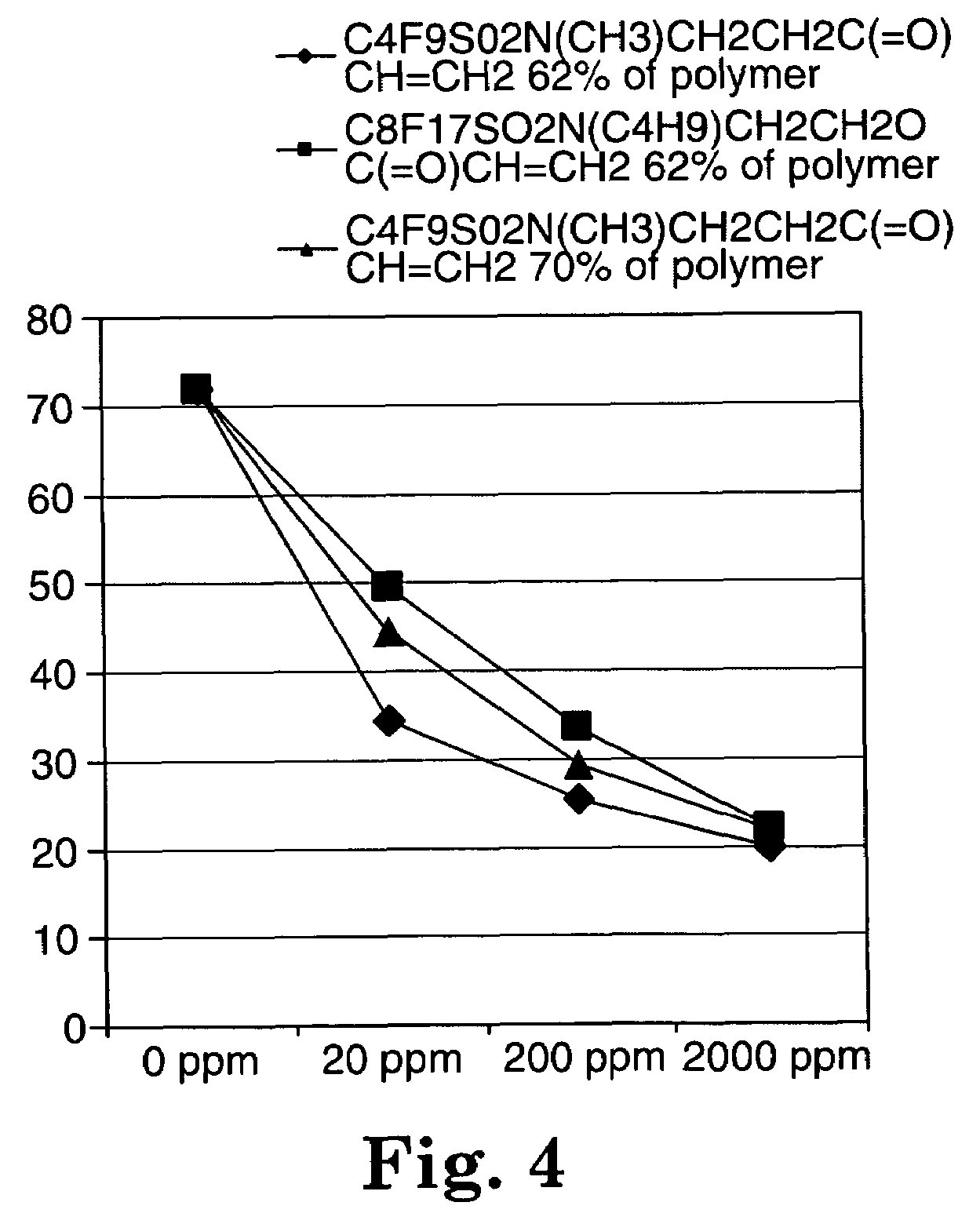Fluorochemical sulfonamide surfactants
a technology of sulfonamide and surfactants, applied in the field of fluorochemical surfactants, can solve the problems of adverse effects on the properties of the composition used in the application, higher cost, etc., and achieve the effect of reducing the surface tension of the liquid
- Summary
- Abstract
- Description
- Claims
- Application Information
AI Technical Summary
Benefits of technology
Problems solved by technology
Method used
Image
Examples
example 1
Preparation of C4F9SO2N(CH3)(CH2CH2O)7.5CH3
[0133]In this example the adduct of MeFBSA (N-methyl-perfluorobutanesulfonamide) and a polyoxyethylene monomethyl ether was prepared.
A. Preparation of MeFBSA (N-methyl-perfluorobutanesulfonamide)
Reaction:
C4F9SO2F+2NH2CH3→C4F9SO2NHCH3+N+H3CH3F−.
Charges:[0134]A. 200 g PBSF (perfluorobutanesulfonyl fluoride) distilled (est 95%, MW=302, 190 g active=0.63 mole).[0135]B. 43 g NH2CH3 (MW=31, 1.38 moles)[0136]C. 300 ml water (2 times)[0137]D. 300 ml 3% H2SO4 [0138]E. 300 ml water (3 times)
Procedure:[0139]1. In a 100 ml flask fitted with a −78° C. cold finger condenser, an overhead stirrer, thermocouple, and a plastic gas inlet tube, Charge A was added. The flask was placed in a water bath, and with stirring the gas addition (Charge B) was started.[0140]2. After 10 minutes of gas addition, the temperature rose only 3° C. The internal temperature was raised by the addition of warm water to the bath to 50° C. and the gas addition rate was increased.[...
example 2
Preparation of MeFBSEA (62%) / CW750 Acrylate (19%) / AMPS (19%)
[0158]In this example a random copolymer of MeFBSEA with CW750 Acrylate and AMPS was prepared.
A. Ethoxylation of MeFBSA with Ethylene Carbonate
Reaction:
C4F9SO2NHCH3+(CH2O)2C═O+Na2CO3(cat)→C4F9SO2N(CH3)CH2OH+CO2
Charges:[0159]A. 100 g MeFBSA (MW=313, 0.32 moles)[0160]B. 2.8 g Na2CO3 (0.026 moles)[0161]D1. 8 g ethylene carbonate (MW=88) melted in oven at 50° C.[0162]D2. 8 g ethylene carbonate[0163]D3. 8 g ethylene carbonate[0164]D4. 10 g ethylene carbonate (total weight=34 g, 0.38 moles)[0165]E. 300 ml water[0166]F. 300 ml water[0167]G. 300 ml 3 wt % sulfuric acid[0168]H. 300 ml water[0169]I. 300 ml water[0170]J. 300 ml water
Procedure:[0171]1. Charges A, B, and C were placed in a one liter 3-necked flask with an overhead stirrer, thermocouple, addition funnel, and reflux condenser.[0172]2. The batch was heated to 60° C. (140° F.) at which point the batch was molten and the stirring was begun. The setpoint was increased to 120...
example 3
Preparation of MeFBSEA (35%) / CW750 Acrylate (65%)
[0202]In the example, the random acrylic copolymer of MeFBSEA with CW750 Acrylate was prepared.
[0203]
Charges:[0204]350 g MeFBSEA (Example 2)[0205]650 g CW750A[0206]40 g t-butyl peroctoate (50% solids)[0207]5 g mercaptopropionic acid[0208]1000 g ethyl acetate
The charges above were added to a 500 ml flask under positive nitrogen pressure. The batch was heated to 79° C. for 6 hours. A total of 2021 g of polymer solution was isolated which when solids were measured was found to be 48.6% of desired product.
PUM
| Property | Measurement | Unit |
|---|---|---|
| refractive index | aaaaa | aaaaa |
| refractive index | aaaaa | aaaaa |
| refractive index | aaaaa | aaaaa |
Abstract
Description
Claims
Application Information
 Login to View More
Login to View More - R&D
- Intellectual Property
- Life Sciences
- Materials
- Tech Scout
- Unparalleled Data Quality
- Higher Quality Content
- 60% Fewer Hallucinations
Browse by: Latest US Patents, China's latest patents, Technical Efficacy Thesaurus, Application Domain, Technology Topic, Popular Technical Reports.
© 2025 PatSnap. All rights reserved.Legal|Privacy policy|Modern Slavery Act Transparency Statement|Sitemap|About US| Contact US: help@patsnap.com



